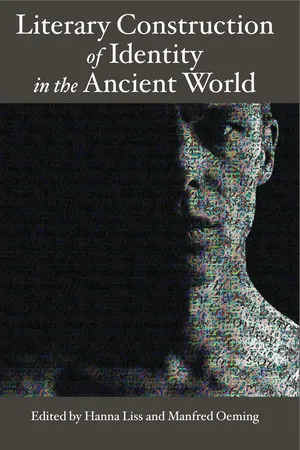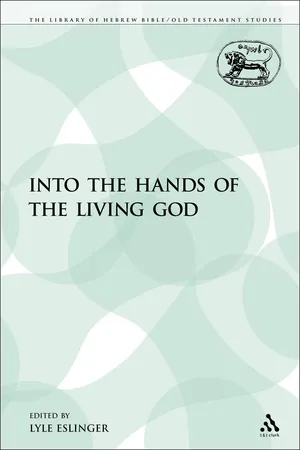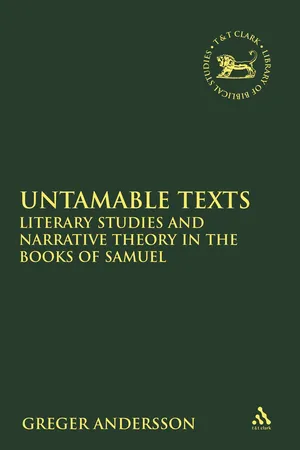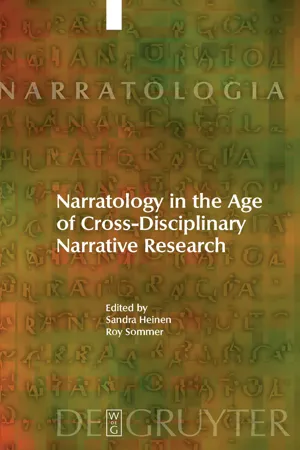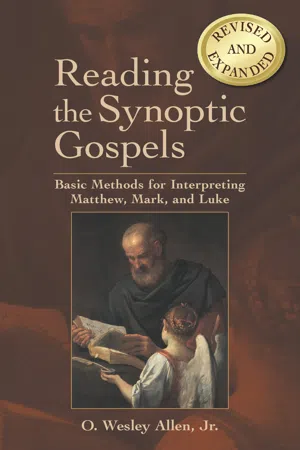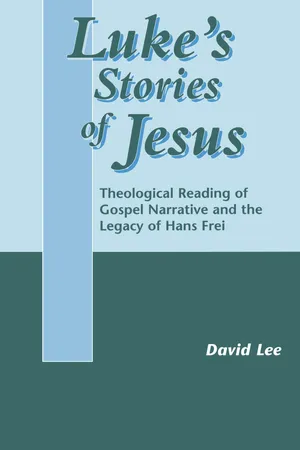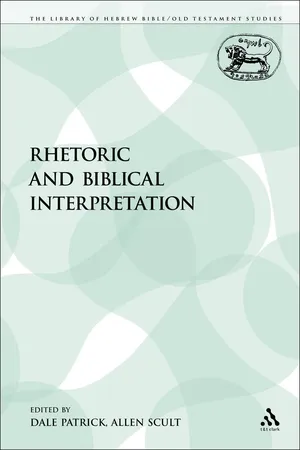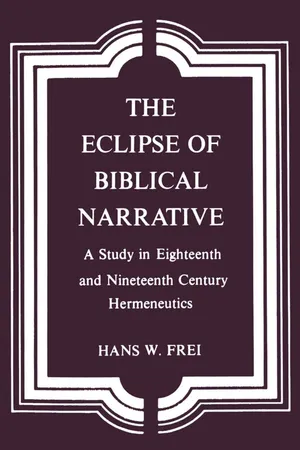Literature
Biblical Narrative
Biblical narrative refers to the stories and accounts found in the Bible, which are often characterized by their historical and moral significance. These narratives are central to the religious and cultural heritage of Christianity and Judaism, and they are studied for their literary and theological value. The biblical narratives encompass a wide range of genres, including creation myths, historical accounts, and parables.
Written by Perlego with AI-assistance
Related key terms
1 of 5
10 Key excerpts on "Biblical Narrative"
- eBook - PDF
Literary Construction of Identity in the Ancient World
Proceedings of the Conference Literary Fiction and the Construction of Identity in Ancient Literatures: Options and Limits of Modern Literary Approach
- Hanna Liss, Manfred Oeming(Authors)
- 2010(Publication Date)
- Eisenbrauns(Publisher)
81 Following the 1963 decision by the U.S. Supreme Court to ban the devotional reading of Bible in public schools, interest in teaching the Bible in literature (that is, discussing literature that alludes to bib- lical texts) and teaching the Bible as literature had strongly increased in the American educational system. The various essays gathered in Lit- erary Interpretations of Biblical Narratives meet this interest. Although there are three studies on New Testament texts, the first volume mainly compiles literary analyses of Old Testament passages from Genesis, Ex- odus, the books of Judges and Ruth, the characters of Elijah, Elisha, and Jonah, as well as a study of the books of Isaiah, Job, and Ecclesiastes. This volume understood itself to be a pioneering venture into rela- tively uncharted territories, because the study of the Bible as literature 79. Compare Booth, Rhetoric of Fiction, 70–75. 80. Thus the English equivalent suggested by Sternberg, Poetics of Biblical Narrative, 52–53. 81. K. R. R. Gros Louis, J. Ackerman, and T. Washaw, eds., Literary Interpretations of Biblical Narratives, vol. 1 (Nashville: Abingdon, 1974). Joachim Vette 38 had not yet produced a significant body of scholarship. 82 The con- tributors to these volumes, the majority of whom belonged to English departments, understood their work as a decisive shift away from what they saw to be the major preoccupation of biblical scholars: the quest for the historical reality behind the biblical text. Instead of play- ing the biblical texts against a supposed underlying historical reality, these authors affirmed that the text itself posits a reality to be under- stood and interpreted in its own right, primarily in terms of its literary craftsmanship. 83 This paradigm shift was exemplified by the term literary criticism. - eBook - PDF
- Lyle Eslinger(Author)
- 1989(Publication Date)
- Sheffield Academic Press(Publisher)
It is difficult to understand how such academics, who usually know Greek, have any more difficulty with narrato-logy than they do with bio-logy, cosm-ology, or the-ology. ** According to G. Genette it is also more appropriate for narratology to study dis-course, since that is the distinctive modal character of this genre alone (see the com-ments of Gerald Prince (1984:867). 12 Into the Hands of the Living God protect this promising new approach to Biblical Narrative against the imperialistic tendencies that have sometimes accompanied methodological developments in biblical studies. Just how suitable is narratology as a tool for biblical study? Approximately 64% of biblical literature is prose. Of that 64% only the pentateuchal legal texts appear to stand outside the nar-rative genre, but even the laws are enclosed within a narrative context. And even those seemingly anti-literary texts have narrative qualities the literariness of which can be appreciated when the conventions within which they were written are un-derstood. 12 All Biblical Narrative is mediated by a narrator. The narrator is the reader's guide, a medium for the duration of the story. The reader is closer to the narrator than to any of the characters in the story. The narrator intervenes between the reader and the world of the story just as our own senses and conceptual faculties intervene between us and our own world (K. Friede-mann 1910:26). As readers, all that we can know about the fic-tional story world is already filtered and interpreted for us by our ears, eyes, and nose—the biblical narrator. There are many different types of narrator, each uniquely prominent and influential on the reader's perception of the story. In the Bible the scale of narratorial prominence is un-evenly balanced. - eBook - PDF
Untamable Texts
Literary Studies and Narrative Theory in the Books of Samuel
- Greger Andersson(Author)
- 2009(Publication Date)
- T&T Clark(Publisher)
It is not relevant only in relation to a particular context as an answer to an implicit or explicit request for information. It is rather a performance; a presentation of a story. If this reasoning were accepted, it would be a mistake to apprehend storytelling as narrative information. It could also be assumed that such a mistake would cause problems in the interpretative praxis relating to issues as gap-lling and the drawing of implications, to seemingly logical conclusions based on a logic that is not valid for this kind of discourse, and so on. These putative problems would then relate to the fact that individual sentences in storytelling do not refer to wordly particulars— they are just components of the story structure as a whole. That is, the structuralist suggestion that a narrative discourse (the whole) should be understood as a sentence writ large was not quite unreasonable. 2.2. An Outline of the Present Chapter The subject of this chapter is how biblical scholars, both adherents of a historical method and those who advocate a literary or narrative approach, understand the “nature” or “character” of the narratives in the books of Samuel. I am especially interested in how their reasoning relates to the two variants I have called, for lack of better terms, “narra-tive information” and “storytelling.” In the chapters to follow I go on to discuss what consequences their apprehension of the “character” of a certain narrative has for their interpretation of it, examining issues as gap-lling and the drawing of implications; the application of distinctions, concepts, and terms from discourse narratology; and ideological interpretation (that is, the under-standing of the ideological message of the text). This chapter has several sections. I rst introduce the biblical texts under consideration with a focus on the question of their character. Next I provide a close reading of the well-known narrative of David and Bathsheba. - Sandra Heinen, Roy Sommer, Sandra Heinen, Roy Sommer(Authors)
- 2009(Publication Date)
- De Gruyter(Publisher)
A NDREAS M AUZ Theology and Narration: Reflections on the “Narrative Theology”-Debate and Beyond * “… that God himself demands narration.” Eberhard Jüngel, Gott als Geheimnis der Welt (1977) 1. Introduction Narrative is a central element in the founding document of Christianity, the Bible. The Bible tells stories: of the creation of the world and of the human race, of the destiny of the chosen people of Israel, of the incarnation of God in Jesus Christ, of the early Christian communities and of the end of the world. For this reason if not for any other the theological reflection of Chris-tian faith will of necessity be concerned with narration. Theology has the task of rendering these stories intelligible in and to its contemporary world— both as individual narratives and in their overall context as the one story of God’s dealings with creation. The narrative quality of the biblical writings is, however, only one of the reasons why storytelling is a pre-eminently theo-logical theme. The Christian tradition that grew out of these narrative foun-dations has itself produced a wealth of stories, which together constitute the history of the church (or rather of Christianity)—a history that unquestiona-bly, and not only from a perspective critical of religion, reads in part as a ‘crime story’ (K.-H. Deschner). Episodes of this story are told and retold in Christian religious education, in school classes or in preparation for confir-mation. The sermon is another locus of narration, frequently in the form of an interpretive retelling of an episode from the life of Jesus—himself a story-teller, as the parables demonstrate. Finally, storytelling is of decisive impor-tance for the individual Christian: why a Christian lives thus and not other-wise is the stuff of narrative: a tale interwoven with the story of Jesus and those other stories that derive from it. In this rudimentary overview ‘history’ and ‘storytelling’ are used in a broad, integral sense.- eBook - ePub
Reading the Synoptic Gospels (Revised and Expanded)
Basic Methods for Interpreting Matthew, Mark, and Luke
- O. Wesley Allen Jr.(Author)
- 2013(Publication Date)
- Chalice Press(Publisher)
Our examination of the literary aspects of Matthew 12:46–50 has both confirmed our earlier observations and advanced our understanding beyond them. We see that each method we use overlaps with others, builds on the observations of others, and offers something new. The focus on the final form of the narrative as literature in this step prepares us for the emphasis on the role of the reader in the next.For Further Reading
Malbon, Elizabeth Struthers. “Narrative Criticism?” In Mark & Method: New Approaches in Biblical Studies, 2nd ed., edited by Janice Capel Anderson and Stephen D. Moore, 29–58. Minneapolis: Fortress Press, 2008.Moore, Stephen D. “Gospel Criticism as Narrative Criticism.” In Literary Criticism and the Gospels: The Theoretical Challenge, 1–68. New Haven/London: Yale University Press, 1989.Pennington, Jonathan T. “Reading the Gospels as Stories: The ‘Whatever Strikes Me’ (WSM) Hermeneutic versus Narrative Analysis.” In Reading the Gospels Wisely: A Narrative and Theological Introduction, 169–82 Grand Rapids: Baker, 2012.Peterson, Norman R. Literary Criticism for New Testament Critics. Philadelphia: Fortress Press, 1978.Powell, Mark Allan. What Is Narrative Criticism? Minneapolis: Fortress Press, 1990._____. “Toward a Narrative-Critical Understanding of Matthew” “…of Mark” “…of Luke.” In Gospel Interpretation: Narrative-Critical & Social-Scientific Approaches, edited by Jack Dean Kingsbury, 9–15, 65–70, 125–31. Harrisburg: Trinity Press International, 1997.Resseguie, James L. Narrative Criticism of the New Testament: An Introduction. Grand Rapids: Baker, 2005.EXCURSUS 3
Select Literary Terms for Narrative Exegesis
ACTION: See PLOT .ALLEGORY: A narrative in which elements of the story (e.g., characters, action, setting) have a symbolic significance as well as a literal significance within the story. Some of Jesus’ parables are allegorical. For example, the parable of the sower is accompanied by an allegorical interpretation (Mk. 4:1–8, 13–20). (See SYMBOL .)APOSTROPHE - eBook - PDF
Luke's Stories of Jesus
Theological Reading of Gospel Narrative and the Legacy of Hans Frei
- David Lee(Author)
- 1999(Publication Date)
- Sheffield Academic Press(Publisher)
will surely be enriched' (Malbon 1992a: 47). 5. The Literary-Critical Potential of Narrative Criticism 141 works. This book is one such exploration, in which a literary reading is considered as a proper preliminary to a theological reading of the Gospel narratives. In recent biblical studies there are three primary perspectives from which to approach the text: (1) the literary; (2) the historical; and (3) the theological. 65 Traditional historical-critical study of the New Testa-ment lies within the purview of (2), while New Testament narrative criticism lies within (1) as a form of literary-critical study. 66 This leaves unresolved the question of what constitutes a 'theological reading' of the Gospel texts. The Formal Role of the Reader. The narrative-critical approach described above omits the real reader in its theoretical model and con-centrates upon the communication within an intratextual process. Nar-rative criticism has never completely abandoned its New Critical for-malist heritage, and continues to treat the text as a self-contained aes-thetic object. 67 This dismissal of the extratextual real reader (and real author) is claimed by these critics to be a necessary enabling condition for the literary appreciation of the story. These 'narrative critics generally speak of an implied reader who is presupposed by the narrative itself...and the goal of narrative criticism is to read the text as the implied reader' (Powell 1990a: 19-20). 68 Yet this suggestion rests upon a category confusion, for the 'implied reader is a literary device encoded in the text in the very rhetoric through 65. These approaches are not dissimilar to Steinberg's suggestion that 'Biblical Narrative [is] a complex, because multi-functional, discourse. Functionally speak-ing, it is regulated by a set of three principles: ideological, historiographical and aesthetic' (Sternberg 1985: 41). - eBook - PDF
Women and the Authority of Scripture
A Narrative Approach
- Sarah Heaner Lancaster(Author)
- 2002(Publication Date)
- Trinity Press International(Publisher)
A construal of the Bible as narrative, then, informs its use as canon in important ways. Because it preserves in its very structure the commitments that formed the identity of the larger Christian community, it serves as the standard for the narrative perspective that identifies this community. It sets the limits within which our various interpretations about God's presence to the world through Jesus Christ ought to fall. Those limits, it turns out, allow for great diversity. Many interpretations have been and continue to be em-braced, and the tension produced by that variety perhaps contributes to the vitality of Christianity because we can never simply rest easily with what has been said before. Creative adaptations to new situations can only take place when there is room to maneuver, a possibility that straight conformity pre-cludes. Some interpretations, though, are ruled out because they threaten the fundamental perspective that Christianity has claimed as its own. READING THE BIBLE AS NARRATIVE 135 If the primary function of the Bible as canon centers on knowing God, we must keep in mind a further point. Human communication is instrumental to God's communication. The authors, compilers, editors, and interpreters of the Bible can make an effort to tell us about God, and we can make an effort to listen carefully to them in order to understand God, but finally we can only dispose ourselves to encounter the God whom we desire to know. One way of talking about this twofold communication is to speak, as Wood sometimes does, of letter and spirit. 21 This distinction, which has a long history in Christ-ian thinking, helps in considering how the words of the text may or may not be revelatory in any given reading. If a text communicates when we under-stand how to make use of it, then it may fail and become dead letter if we have lost the ability to grasp the conventions needed for employing its con-cepts. On that level, even human communication breaks down. - eBook - PDF
- Dale Patrick, Allen Scult(Authors)
- 1990(Publication Date)
- Sheffield Academic Press(Publisher)
21 2. The Rhetorical Character of Biblical Narrative 41 For our purposes, however, there is one striking similarity between Rabbinic interpretation and the Bible as well as a dissimilarity between Rabbinic and Greek thought which must be noted. Like the Bible, a central form in Rabbinic interpretation is the narrative. On the other hand, there is a total absence of anything like Greek philosophy in Rabbinic thought even though the possibilities for borrowing philosophical motifs were there. This preference for narrative as over against another prevalent motif is reminiscent of an earlier preference for narrative over the dominant epic form. The Rabbis' preference for the narrative form can also be seen as a corollary of the Bible's innovative narrative theology. The Bible begins with one very clear and unambiguous assertion which appears to determine that the primary mode of Biblical interpretation will be narrative rather than philosophy. That assertion is that the creation of the world is an unexplainable willing, a seemingly arbitrary exercise of authority. Why does God create the world? We are not told. Philosophy, especially as practiced by the Greeks, requires that there be certain axioms—first principles— which provide a solid grounding for reality. But the Biblical doctrine of creation presents no such solidly grounded first principles. 'In the beginning, God created heaven and earth...' All is contingent upon the seemingly arbitrary exercise of God's will, implying very strongly that it all could have been otherwise. This contingent quality is the stuff of stories and of rhetoric, not of philosophy. The story particularizes one possibility among the many that could have been. The choice to tell it this way rather than that is one of strong moral import. The narrator strongly implies that it happened this way rather than that for a reason, a reason that has to do with the moral order of the world as the narrator sees it. - eBook - PDF
The Eclipse of Biblical Narrative
A Study of Eighteenth and Nineteenth Century Hermeneutics
- Hans W. Frei(Author)
- 1980(Publication Date)
- Yale University Press(Publisher)
It is at least possible that in iregard to realistic narrative literature, the function of general heimeneutics should be formal rather than material; it should be confined to identifying a piece of literature as belonging to that particular genre .rather than some other, rather than claim to interpret its meaning or subject matter. As for the latter task, there may be no single interpretive device to satisfy it (nor is there necessarily any need for such a weighty interpretive device!), due to the nature of this type of literature. And it does not matter whether it is found in the Bible or elsewhere. In a sense, every narrative of the sort in which story and meaning are closely ^related may have its own special hermeneutics* While such a distinction between general and special hermeneuties, corresponding to the distinction (in narra-tives) between genre specification and understanding of meaning, is not the same as Ernesti's distinction between understanding the sense of the words ancl understanding the subject matter and confining the task of interpretation to the former, there is no denying an affinity between the two suggestions. The mythophiles noted that the gap between representation 274 THE ECLIPSE OF Biblical Narrative and what is represented, between narrative shape and meaning, is not so great in the simpler history-like biblical myths as in some others. They noted this feature quite obviously at points in the Bible where ^miracles and inexperieheeable data are being narrated* Hence the difference they sensed between biblical and other myths is obviously not the same for them as the difference between historical fact and fiction. Since all miraculous and inexperienceable features were obviously fictional for them, the difference between the simple and the embellished; the more-and vthe less history-like, should in fact have been for them nothing other than a difference between one kind of narrative writing and another. - eBook - PDF
At the Mountain of God
Story and Theology in Exodus 32-34
- R. W. L. Moberly(Author)
- 1983(Publication Date)
- Sheffield Academic Press(Publisher)
It is in this connection that the currently fashionable notion of story is of assistance. One of the advantages of the term story is that it is conveniently vague about the precise nature of the material to which it is applied but focusses rather on those elements which bring a narrative to life -plot, irony, suspense, climax, etc. - and which involve the reader imagin-atively in the material. The important thing is to grasp what is being said. Questions about truth content, process of composition, or historical reliability may indeed be addressed to a story, and some stories positively invite such questions, but they are distinct from the task of understanding and entering into what the story is saying and may, in general, be left aside until the primary task of understanding has been accomplished. One should not, however, separate the questions of under-standing and truth too sharply, for it is often precisely by appealing to a reader's sense of what is true to life that the story involves the reader in what is being said. Utilizing, then, the notion of story one can concentrate in the first instance on a straightforward reading of the text and postpone explicitly addressing the issue of the precise nature of the story's contents. To carry out such a procedure with Ex. 32-34 fits well with the tenor of the argument so far. For most pentateuchal genre discussions tend to be concerned with either the historicity or the traditio-historical development of the material rather than illuminating the meaning of what is being said. This may be seen by briefly considering the two main genre classifications that have been suggested for the Sinai material.
Index pages curate the most relevant extracts from our library of academic textbooks. They’ve been created using an in-house natural language model (NLM), each adding context and meaning to key research topics.
